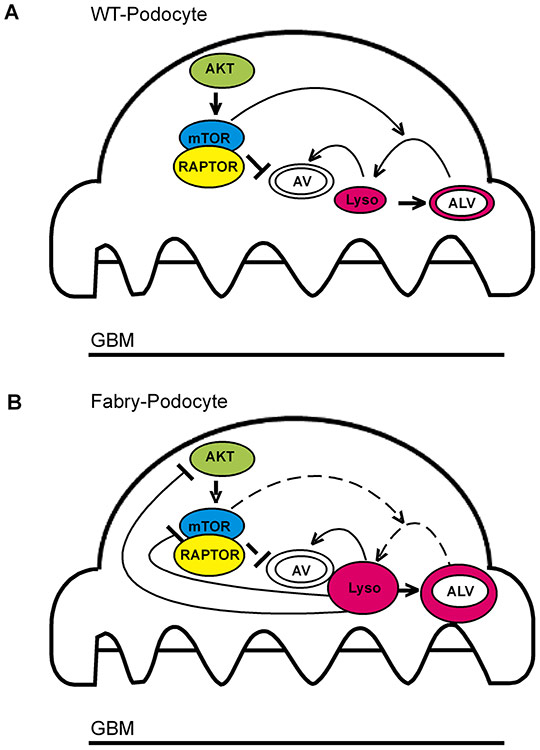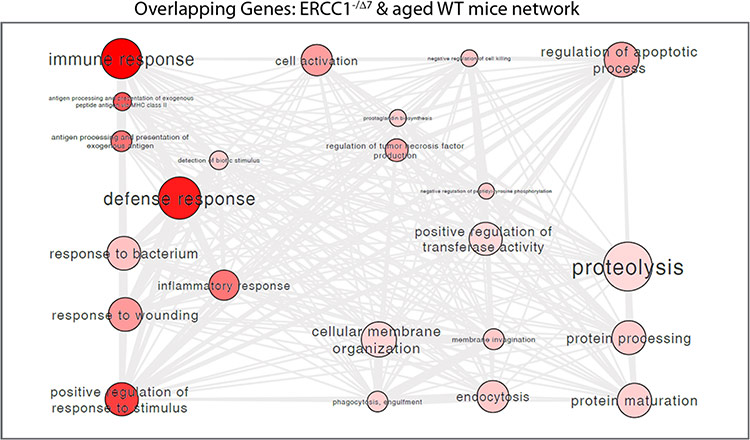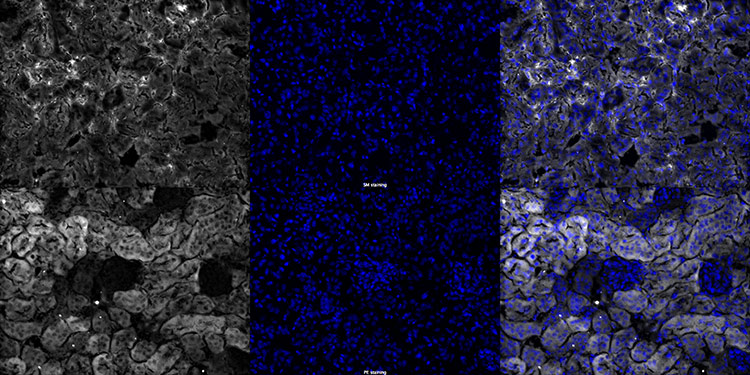CHANNELS

Group Leader
Prof. Dr. med. Christine Kurschat
+49 221 478-4480
christine.kurschat@uk-koeln.de
TEAM MEMBERS
Linda Blomberg
Amrei Mandel
Lisa Quint
Christine Kurschat
Podocyte ageing and Fabry’s disease
The worldwide demographic increase in the elderly population will become a major health concern for modern societies in the future. Aging-related chronic kidney disease is a common problem of aged individuals, presenting with mild to severe impairment of kidney function. Yet, models to study renal aging are currently lacking. In order to identify molecular mechanisms involved in glomerular and kidney aging we analyze gene expression profiles, protein profiles and lipid profiles of young and aged kidney tissue. The aim of our research project is to identify molecules and pathways involved in the process of kidney aging to develop novel prevention strategies of age-related kidney function decline and therapies for healthy aging.
Fabry disease results from an inborn error of glycosphingolipid metabolism. Due to a mutation in the GLA gene on the X-chromosome activity of the lysosomal enzyme alpha galactosidase A (alpha-gal) is reduced or totally abolished. Neutral glycosphingolipids, mainly globotriaosylceramide (Gb3), accumulate in various tissues, including the kidneys. End-stage renal disease is one of the most common causes of death in hemizygous males with Fabry disease. The mechanism underlying proteinuria, hematuria, and kidney failure is not well understood. Histological studies suggest an important role for podocytes in the pathogenesis of glomerular damage. We developed a human podocyte model of Fabry’s disease by reducing alpha-gal activity in human podocytes, leading to progressive accumulation of intracellular Gb3. Interestingly, these changes are accompanied by a loss of mTOR kinase activity, a negative regulator of the autophagic machinery. Thus, dysregulated autophagy in alpha galactosidase A-deficient podocytes may contribute to podocyte malfunction in Fabry disease. Our research provides a promising new direction for further studies on the pathomechanism of glomerular injury in Fabry patients.



SELECTED PUBLICATIONS
Lenders, M., Nordbeck, P., Kurschat, C., Eveslage, M., Karabul, N., Kaufeld, J., Hennermann, J.B., Patten, M., Cybulla, M., Muntze, J., Uceyler, N., Liu, D., Das, A.M., Sommer, C., Pogoda, C., Reiermann, S., Duning, T., Gaedeke, J., von Cossel, K., Blaschke, D., Brand, S.M., Alexander Mann, W., Kampmann, C., Muschol, N., Canaan-Kuhl, S., and Brand, E. (2021) Treatment of fabry disease with migalastat-outcome from a prospective 24 months observational multicenter study (FAMOUS). Eur Heart J Cardiovasc Pharmacother.
Braun, F., Blomberg, L., Akbar-Haase, R., Puelles, V.G., Wong, M.N., Rahmatollahi, M., Fermin, D., Slaats, G.G., Koehler, S., Brinkoetter, P.T., Lindenmeyer, M.T., Cohen, C.D., Kann, M., Bloch, W., Sampson, M.G., Huber, T.B., Schermer, B., Benzing, T., Schumacher, B., and Kurschat, C.E. (2021) DNA damage activates mTORC1 signaling in podocytes leading to glomerulosclerosis. bioRxiv: 2020.09.13.295303.
Braun, F., Rinschen, M., Buchner, D., Bohl, K., Plagmann, I., Bachurski, D., Richard Spath, M., Antczak, P., Gobel, H., Klein, C., Lackmann, J.W., Kretz, O., Puelles, V.G., Wahba, R., Hallek, M., Schermer, B., Benzing, T., Huber, T.B., Beyer, A., Stippel, D., Kurschat, C.E., and Muller, R.U. (2020) The proteomic landscape of small urinary extracellular vesicles during kidney transplantation. J Extracell Vesicles, 10(1): e12026.
Braun, F., Blomberg, L., Brodesser, S., Liebau, M.C., Schermer, B., Benzing, T., and Kurschat, C.E. (2019) Enzyme Replacement Therapy Clears Gb3 Deposits from a Podocyte Cell Culture Model of Fabry Disease but Fails to Restore Altered Cellular Signaling. Cell Physiol Biochem, 52(5): 1139-1150.
Slaats, G.G., Braun, F., Hoehne, M., Frech, L.E., Blomberg, L., Benzing, T., Schermer, B., Rinschen, M.M., and Kurschat, C.E. (2018) Urine-derived cells: a promising diagnostic tool in Fabry disease patients. Sci Rep, 8(1): 11042.
Braun, F., Rinschen, M.M., Bartels, V., Frommolt, P., Habermann, B., Hoeijmakers, J.H., Schumacher, B., Dolle, M.E., Muller, R.U., Benzing, T., Schermer, B., and Kurschat, C.E. (2016) Altered lipid metabolism in the aging kidney identified by three layered omic analysis. Aging (Albany NY), 8(3): 441-57.
Schermer, B., Bartels, V., Frommolt, P., Habermann, B., Braun, F., Schultze, J.L., Roodbergen, M., Hoeijmakers, J.H., Schumacher, B., Nurnberg, P., Dolle, M.E., Benzing, T., Muller, R.U., and Kurschat, C.E. (2013) Transcriptional profiling reveals progeroid Ercc1(-/Delta) mice as a model system for glomerular aging. BMC Genomics, 14: 559.
Liebau, M.C., Braun, F., Hopker, K., Weitbrecht, C., Bartels, V., Muller, R.U., Brodesser, S., Saleem, M.A., Benzing, T., Schermer, B., Cybulla, M., and Kurschat, C.E. (2013) Dysregulated autophagy contributes to podocyte damage in Fabry's disease. PLoS One, 8(5): e63506.
